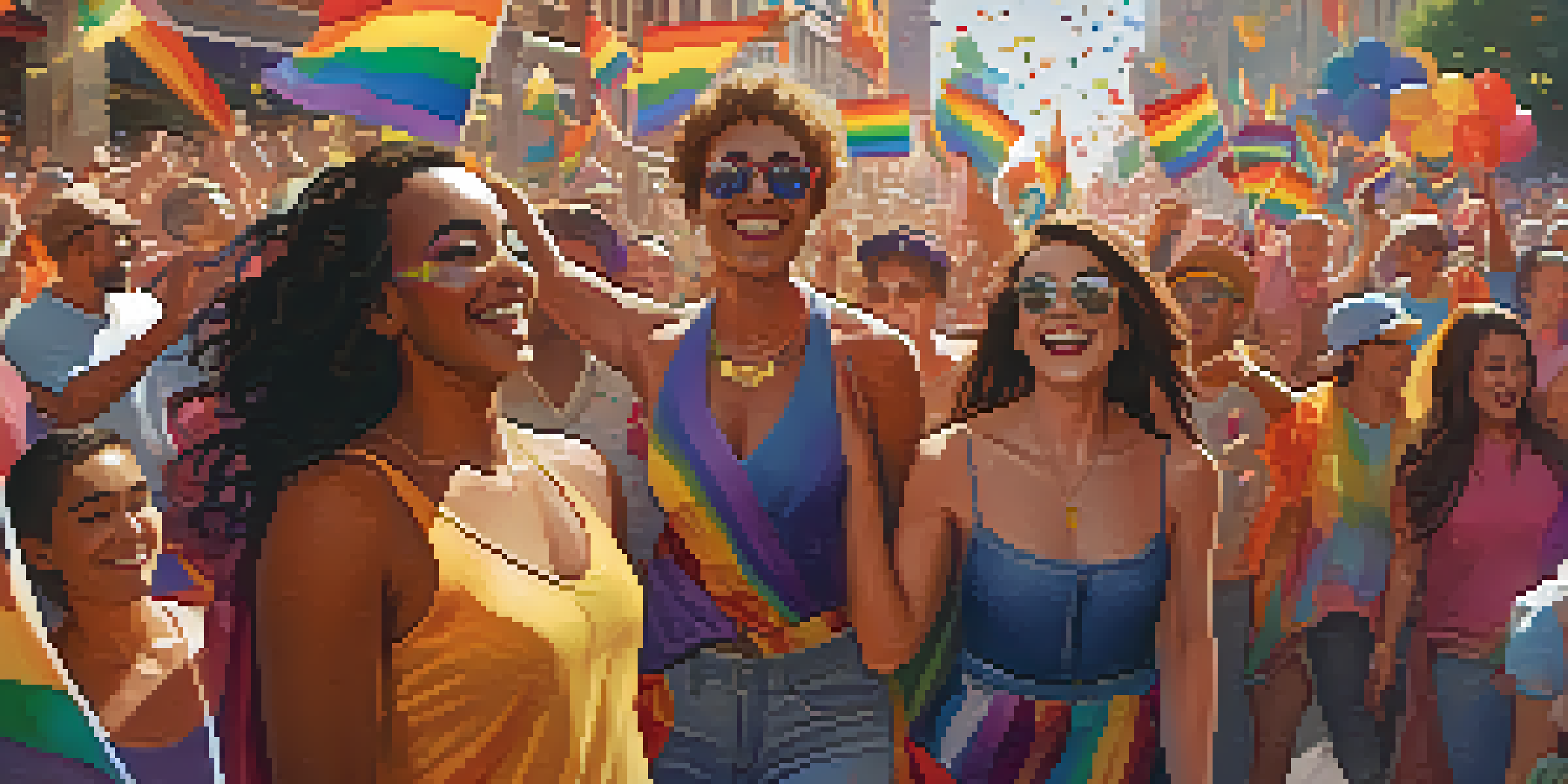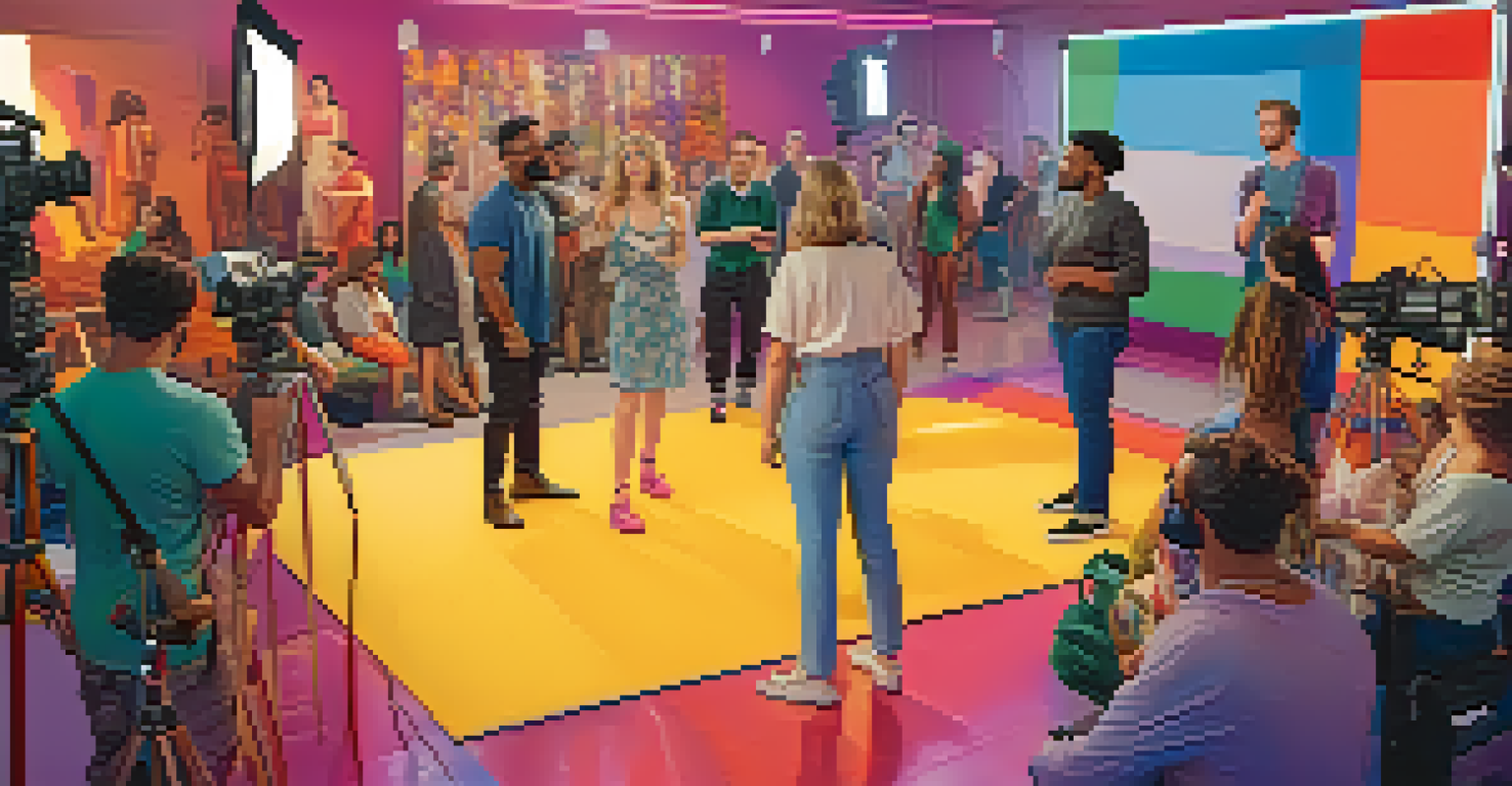LGBTQ+ Representation in LA's Film and Television Industry

The Historical Context of LGBTQ+ Representation in Film
LGBTQ+ representation in film has evolved significantly over the decades, particularly in Los Angeles, the heart of the entertainment industry. In the early days, LGBTQ+ characters were often relegated to stereotypes or depicted in a negative light, limiting their complexity and depth. However, as societal attitudes began to shift, so too did the portrayal of LGBTQ+ individuals in films, moving towards more authentic and nuanced representations.
Representation matters. It is not just about visibility, but about the depth and authenticity of stories being told.
During the 1970s and 1980s, films like 'The Rocky Horror Picture Show' and 'Paris is Burning' began to challenge existing narratives, offering audiences a glimpse into LGBTQ+ culture and experiences. These films played a crucial role in not just entertaining but educating the public, paving the way for more diverse stories. By showcasing the lives, struggles, and triumphs of LGBTQ+ individuals, they also encouraged a broader acceptance within mainstream society.
Today, we see a wider range of LGBTQ+ stories being told across various genres, reflecting the community's diversity. From romantic comedies to dramatic narratives, the representation has expanded, allowing for characters that resonate with audiences on multiple levels. This shift not only enriches the storytelling landscape but also affirms the importance of visibility in the media.
Current Trends in LGBTQ+ Representation on Screen
In recent years, there has been a notable increase in the quantity and quality of LGBTQ+ representation in film and television. Shows like 'Pose' and 'Schitt's Creek' have not only featured LGBTQ+ characters but have also placed them at the center of their narratives, showcasing their stories with authenticity and depth. This has resulted in a more accurate portrayal of the LGBTQ+ experience, moving beyond tokenism to genuine representation.

Moreover, platforms like Netflix and Hulu have made a concerted effort to include LGBTQ+ stories in their programming, recognizing the demand for diverse narratives. This shift indicates a broader acceptance and understanding of LGBTQ+ issues among audiences, further encouraging creators to explore these themes. As a result, we’re seeing more filmmakers and writers from the LGBTQ+ community stepping into the spotlight, sharing their unique perspectives.
Evolution of LGBTQ+ Representation
LGBTQ+ representation in film has transformed from negative stereotypes to authentic narratives reflecting diverse experiences.
However, it’s essential to note that representation still varies widely across genres and demographics. While progress has been made, there are still many stories left untold, particularly those of LGBTQ+ people of color and transgender individuals. The industry must continue to push for inclusive storytelling that reflects the full spectrum of the community.
The Impact of LGBTQ+ Representation on Society
LGBTQ+ representation in film and television significantly impacts societal perceptions and acceptance. When audiences see diverse LGBTQ+ characters and stories, it helps to normalize these identities, fostering empathy and understanding. This visibility can be particularly crucial for young LGBTQ+ individuals who may be struggling with their identity, as it validates their experiences and provides role models.
The power of media representation is that it shapes our understanding of who we are and who we can become.
Films and shows that portray LGBTQ+ characters in positive, complex roles can challenge harmful stereotypes and misconceptions. For instance, characters that display depth and resilience can help to dismantle the stigma often associated with the community. This shift in narrative not only benefits LGBTQ+ individuals but also educates wider audiences, promoting inclusivity and acceptance.
Furthermore, the effects of representation extend to various spheres, including politics and social justice. As LGBTQ+ stories gain traction in mainstream media, they can influence public policy and attitudes towards LGBTQ+ rights. Increased visibility can lead to greater support for legislation that protects LGBTQ+ individuals, ultimately contributing to a more equitable society.
Challenges Facing LGBTQ+ Filmmakers in Hollywood
Despite the progress made in LGBTQ+ representation, filmmakers from the community still face numerous challenges in Hollywood. One significant hurdle is the struggle for funding and support, as many studios remain hesitant to take risks on LGBTQ+ narratives that diverge from mainstream expectations. This often results in a limited number of projects making it to production, stifling diverse voices and stories.
Moreover, LGBTQ+ creators often encounter pressure to conform to stereotypes or to tone down their narratives to appeal to broader audiences. This can lead to a dilution of their stories, stripping them of the authenticity and cultural significance that makes them impactful. When LGBTQ+ creators are unable to tell their stories in their own words, it undermines the very essence of representation.
Impact on Society and Acceptance
Positive portrayals of LGBTQ+ characters in media foster empathy and understanding, influencing societal attitudes and policies.
Additionally, there is the ongoing issue of intersectionality within the LGBTQ+ community. Filmmakers who identify as LGBTQ+ people of color, for example, may face unique barriers that are not as readily acknowledged. Addressing these challenges requires a commitment from the industry to create more inclusive spaces that empower all voices within the LGBTQ+ spectrum.
The Role of Independent Cinema in LGBTQ+ Storytelling
Independent cinema has historically been a vital platform for LGBTQ+ storytelling, offering a space for authentic voices that might otherwise be overlooked in mainstream film and television. Independent filmmakers often have the creative freedom to explore complex, nuanced narratives that reflect their personal experiences, leading to more genuine representations of the LGBTQ+ community. This authenticity resonates with audiences and builds a loyal following.
Films like 'Moonlight' and 'The Handmaiden' have gained critical acclaim and contributed to the visibility of LGBTQ+ stories in the independent sector. These films not only offer powerful narratives but also challenge the conventions of traditional storytelling, pushing boundaries and encouraging audiences to engage with diverse perspectives. The success of such films demonstrates that there is a significant appetite for independent LGBTQ+ cinema.
Moreover, festivals dedicated to LGBTQ+ films, such as Outfest and Frameline, play a crucial role in promoting these stories and connecting filmmakers with audiences. They provide a platform for emerging talent and facilitate discussions around representation and visibility. As independent cinema continues to thrive, it remains an essential avenue for elevating LGBTQ+ voices in the film industry.
The Future of LGBTQ+ Representation in Film and TV
Looking ahead, the future of LGBTQ+ representation in film and television appears promising, but not without its challenges. As audiences continue to demand more diverse stories, there is potential for increased investment in LGBTQ+ narratives from major studios and streaming platforms. This could lead to a broader range of stories being told, reflecting the rich tapestry of LGBTQ+ experiences.
However, it’s crucial for the industry to prioritize authenticity in these narratives. As we see more LGBTQ+ stories being produced, it’s essential that the voices behind the camera reflect the diversity of the characters on screen. Hiring LGBTQ+ writers, directors, and producers will ensure that stories are told with the nuance and respect they deserve, leading to more impactful representation.
Challenges for LGBTQ+ Filmmakers
Despite progress, LGBTQ+ filmmakers face hurdles like funding struggles and stereotype pressures, hindering authentic storytelling.
Additionally, as discussions around intersectionality gain traction, it’s vital that the industry recognizes and represents the experiences of LGBTQ+ individuals from various backgrounds. By embracing this diversity, filmmakers can create narratives that resonate with a wider audience while also addressing the complexities of identity. The future of LGBTQ+ representation hinges on the commitment to authenticity, inclusivity, and understanding.
Celebrating LGBTQ+ Voices in the Entertainment Industry
Celebrating LGBTQ+ voices in the entertainment industry is essential for fostering a culture of inclusivity and acceptance. Acknowledging the contributions of LGBTQ+ artists and creators not only enriches the storytelling landscape but also empowers others within the community to share their stories. Events like Pride celebrations and LGBTQ+ film festivals play a crucial role in highlighting these voices and creating spaces for dialogue.
Moreover, recognizing and awarding LGBTQ+ talent within the industry can further validate their experiences and encourage more diverse storytelling. Awards shows that include categories for LGBTQ+ films and performances help to elevate these narratives and inspire future creators. Visibility in these spaces is essential for breaking down barriers and creating a more inclusive entertainment industry.

As we celebrate LGBTQ+ voices, it's important to remember that representation matters. By amplifying these stories, we contribute to a culture that values diversity and fosters understanding. The ongoing commitment to uplifting LGBTQ+ voices will not only transform the entertainment industry but also pave the way for a more inclusive society.